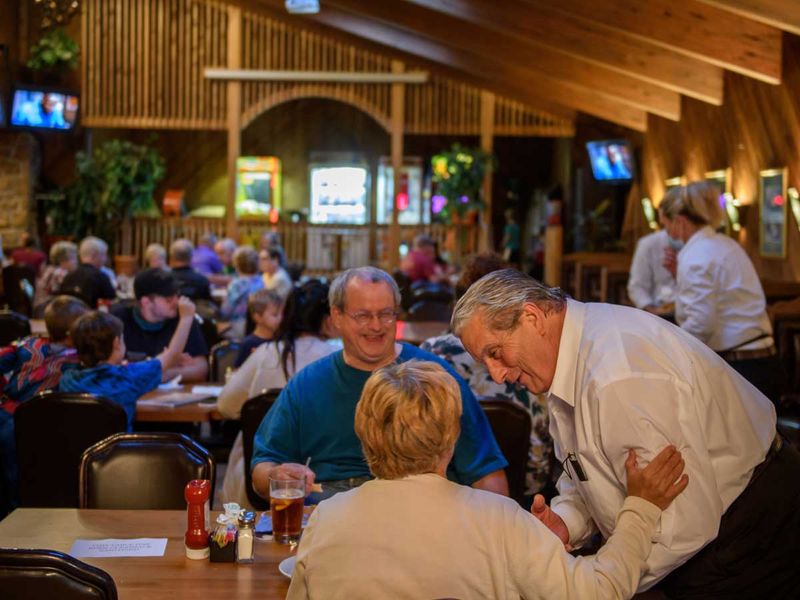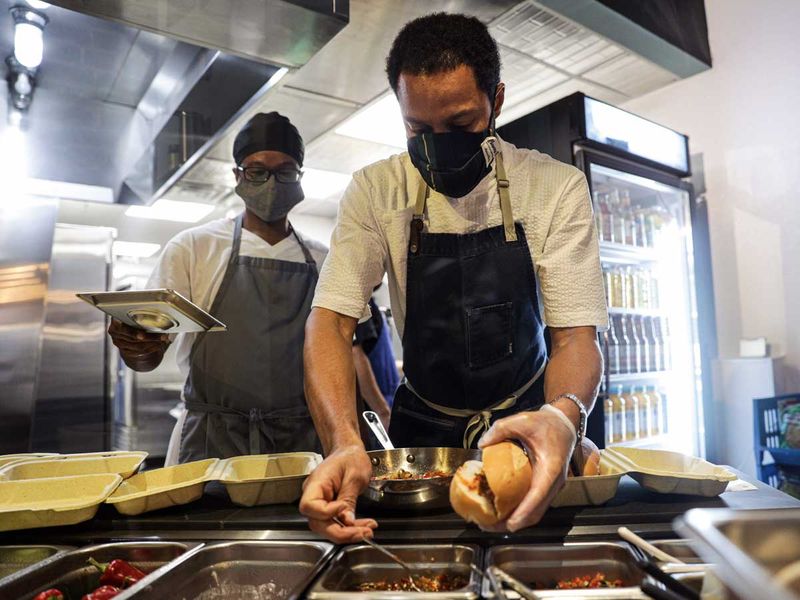US Democratic vice-presidential candidate Senator Kamala Harris and her husband Doug Emhoff go to Amaize, a restaurant in Doral, Florida, on September 10, 2020.
Image Credit: The New York Times
When the pandemic hit America’s restaurants, it was as if an anvil dropped — on a bubble.
To run a restaurant, any sort of restaurant, is a continuing wrestle to maintain that bubble aloft. Every day is a negotiation: of labour prices, meals prices, lease, insurance coverage, well being inspections, and the artwork and craft of making an expertise particular sufficient to maintain individuals coming via the doorways. When the pandemic lockdown pressured lots of of 1000’s of institutions to shut, there was no backup plan. No one was ready for the extent of the fallout.
The restaurant and quick meals trade, the second-largest non-public employer within the United States, collapsed in a single day. At least 5.5 million jobs evaporated by the tip of April, and the variety of individuals employed in meals companies continues to be 2.5 million fewer than in February. Technomic, a consulting agency for the food-service trade, estimates that 20 per cent to 25 per cent of independently owned restaurants won’t ever reopen. And these restaurants uphold an ecosystem that extends to farms, fishmongers, florists, ceramicists, wineries and extra. The harm has been so extreme that the James Beard Foundation introduced in August that it will cancel its restaurant awards this 12 months due to the pandemic and a necessity to re-examine structural bias.
The most deeply affected had been restaurant staff, who had been both laid off in order that they might file for unemployment or had been requested to maintain working and danger their well being. These are individuals who usually would not have entry to medical insurance, earn lower than a residing wage and disproportionately embody undocumented staff, immigrants, and Black and brown individuals — probably the most marginalised individuals on this nation.
As the nation begins to open up and restaurants slowly invite prospects again in — New York City introduced on Wednesday that indoor eating might resume at 25 per cent capability — a lot of those self same individuals are being requested to come again to work, with no change to their compensation or guarantees of help in case they get sick. (Plenty of restaurants have even had to shut after reopening as a result of staff examined constructive for the virus.)
It’s unfathomable to think about a rustic with out restaurants, however much more unfathomable to think about a profitable financial restoration that doesn’t embody restaurant workers. As such a big slice of the American work pressure, they don’t seem to be solely important to development. How we assist them can be a litmus take a look at for whether or not the United States can ever construct a good, equitable financial system.
How the restaurant mannequin is altering
Rebuilding the restaurant enterprise can’t be nearly diversifying income streams. It requires rethinking how employers and patrons worth labour, which implies shifting the restaurant mannequin to one which’s centred on staff.
The onus for change mustn’t fall solely on restaurants. The success of a worker-centred method, particularly in the course of a recession, requires cooperation from prospects and assist from authorities. With many restaurants now welcoming prospects who’re tiring of house cooking after an prolonged lockdown, and getting nationwide consideration by policymakers, that is the time to make a structural shift.
The restaurants finest outfitted to kick-start this variation received’t be these which can be a part of bigger empires in densely populated, high-cost-of-living cities like New York and San Francisco. In truth, outdoors the fast-food trade, many restaurants in America have just one location. These are the locations that don’t have a big company infrastructure. They are run by a small group of individuals, usually members of the family. They purchase components from native producers. They are the lifeblood of their communities, and for them, survival is about extra than simply protecting a enterprise working.

Image Credit: The Washington Post
Every restaurant ought to find a way to discover a mannequin narrowly tailor-made to its staff and group, as long as there’s additionally a broader public security internet.
–
They are restaurants like The Four Way, a 74-year-old soul-food establishment in Memphis. At the start of March, it was racking up file gross sales of its fried catfish and peach cobbler. Once the pandemic hit, Patrice Bates Thompson, the proprietor, had to make adjustments quick. Like many different restaurateurs, she shifted to largely takeout and supply, has been shopping for her workers groceries when buying meals for the restaurant and helps a number of of them cowl their utility payments.
Nearly each restaurant that survived the pandemic to this point has had to regulate its operations in to survive. The shift to takeout is probably probably the most seen and lasting change for restaurants. Takeout and supply companies have allowed 1000’s of restaurants everywhere in the nation to survive, and the expertise is evolving as restaurants apply their creativity to this now ubiquitous kind. Seven Reasons, a fine-dining restaurant in Washington, bundles orders with cocktails in Mason jars and sends prospects hyperlinks to Spotify playlists to pay attention to whereas they’re consuming — a lockdown-appropriate approximation of eating out. Junzi Kitchen, a mini-chain of Chinese restaurants in New York and Connecticut, was impressed by restaurants in China to design an interactive, rotating takeout menu, with an accompanying Instagram Live by the chef, Lucas Sin, explaining the story behind every dish and the way to plate it. Other restaurants have become grocery shops, providing their premium components to house cooks. The New York restaurateur Gabriel Stulman began promoting meal kits out of his West Village spot, Jeffrey’s Grocery, in order that prospects can replicate well-liked dishes at house.
These improvements will definitely assist restaurants to grasp on within the close to time period, maintain paying their workers and even improve income as soon as dine-in service is extra prevalent.
What ideas imply for restaurant staff
But they don’t confront the bigger difficulty: The enterprise mannequin of restaurants is constructed on the belief of low cost labour. One out of six restaurant staff reside beneath the poverty line, in accordance to the Economic Policy Institute, and the trade has an exceptionally excessive turnover price — 75 per cent in 2018, in accordance to the Bureau of Labour Statistics, in contrast with 49 per cent for the remainder of the non-public sector. In different phrases, jobs within the restaurant trade look more and more like gig work — unstable, poorly paid and with few protections for staff.
To make it worse, the follow of tipping front-of-house staff (servers, bartenders and hosts), which is deeply ingrained within the tradition and enterprise mannequin of restaurants, creates a disparity in earnings between front- and back-of-the-house staff, privileges white staff, who’re extra doubtless to work within the entrance of the home, and fuels sexual harassment. The Bureau of Labour Statistics experiences that the median hourly wage for cooks is $12.67 and $11 for servers, however the IRS estimates that about 40 per cent of ideas go unreported, which might inflate that server’s hourly wage to $15.40.
Anakaren Ibarra-Dumovich, a former sous chef at Rye Plaza in Kansas City, Montana, stated that too many restaurants are reopening with out contemplating what counting on ideas for earnings means for staff. If individuals aren’t eating out as a lot, she defined, tip earnings might fall drastically and staff might find yourself returning to the identical job for a lot much less cash. But in the event you’re provided work and don’t take it, you not qualify for unemployment. “Either you work and risk potential exposure and make no money or you lose all of it,” she stated. “It is scary.”

Image Credit: Reuters
Who goes to need, a lot much less find a way, to pay extra for meals in the course of a recession? And diminished capability in restaurants can even imply diminished labour.
–
Devita Davison, the chief director of FoodLab Detroit, an incubator for socially minded meals companies, believes the trade wants to use this era of upheaval to suppose extra radically. “The question is not ‘What does the restaurant look like?’ but ‘What does it mean to have a profitable restaurant?’” she stated. “Because guess what, for the sake of profitability, who suffers?”
This is the tougher query, and one which a number of restaurants are beginning to reply. One of FoodLab’s companion restaurants, PizzaPlex, in southwest Detroit, is already working to generate sufficient income to turn out to be a worker-owned cooperative, the place each worker has a monetary stake within the enterprise and has a say in main choices. For the house owners, Alessandra Carreon and Drew McUsic, the purpose shouldn’t be to maximise income for the 2 of them however to redistribute the wealth generated by their restaurant again into the group.
There are different methods for a restaurant to change its relationship with staff. Melissa Miranda owns Musang in Seattle, a restaurant she calls “Filipinx” to honour the genderqueer individuals she is aware of amongst immigrants from the Philippines in white American neighbourhoods. She instituted a single hourly wage throughout the board, with a tip pool divided by hours of labor. She closed Musang for dine-in service earlier than the stay-at-home order was issued in Seattle, as a result of a lot of her workers reside in multigenerational properties with older members of the family.
Turning restaurant right into a group kitchen
She turned the restaurant right into a group kitchen open two days every week, the place individuals can choose up a free meal on a primary come first served foundation. Her crew delivers meals three days every week, and that work is supported by donations from suppliers and prospects. (About 75 per cent of on-line orders embody donations, she stated.) Musang’s takeout and outside eating gross sales are buoying the kitchen’s work as effectively, now that income has returned nearly to what it was earlier than the pandemic and the restaurant is worthwhile once more.
The pandemic pressured Miranda to re-examine what it means to run a restaurant: How do you present medical insurance throughout a pandemic when margins are so slim? What do you do with front-of-house staff while you’re a great distance from dine-in service? How are you able to mentor workers and encourage them to turn out to be enterprise house owners themselves?
She has made some concrete adjustments. She eradicated tipping and plans to supply everybody on her employees well being care and retirement advantages. She has diminished the dimensions of her employees in order that she will be able to pay them extra — between $25 and $30 an hour — and spend extra time on coaching them and instructing them concerning the enterprise. “I have worked in this industry a long time,” Miranda advised me. “I never had a 401(k) or benefits or anyone looking out for my financial future.” Musang, she hopes, can be completely different. The old-school mannequin of restaurants is solely about income. “We didn’t build this restaurant for that,” she stated. “We built this restaurant with the intent to make change.” She desires it to be the final place her workers work earlier than they open up their very own restaurant.
Restaurants, staff and diners are left to make moral calculations of their very own. Close without end or reopen below unsafe situations? Take a job in hurt’s method or forfeit a paycheque? Support a neighborhood restaurant or danger a server’s well being for a plate of enchiladas?
–
Francesca Hong, the chef and a co-owner of Morris Ramen in Madison, Wisconsin, additionally began a group kitchen, which she and one other restaurant group, Rule No. One, have expanded into an initiative known as Cook It Forward Madison. The challenge works with non-profit to present meals to individuals in want. In flip, the non-profit present the restaurant with monetary and technical help, like accounting and authorized help.
That help, plus donations via Cook It Forward Madison, allowed her to supply 100 per cent of her employees their jobs again. (About three-quarters of them accepted.) It additionally implies that she will get to maintain shopping for from native farms and different producers, making certain that these benefiting from the restaurant embody not simply her workers, but in addition the broader group of staff that assist it. (Hong has additionally turn out to be extra energetic in the neighborhood politically; she is a candidate for a Wisconsin State Assembly seat.)
All of this effort to give you new enterprise fashions will accomplish little except restaurant patrons perceive the true prices of labour. Communication is vital. Miranda, for instance, has raised menu costs whereas making an attempt to maintain the restaurant accessible to locals. “If we were to introduce a 20 per cent service charge, that would be a bit of a shock,” she stated. So she has shifted the restaurant’s repertoire to extra vegetable-heavy dishes, in order that she will be able to spend much less on meat and extra on worker compensation. The menu features a word to prospects on how the price of caring for workers is factored into meals costs. Not being clear with friends “is where the pushback happens,” she advised me.

Image Credit: The New York Times
How to observe security tips whereas nonetheless being profitable
The rustic Berkshires restaurant, the Prairie Whale in Great Barrington, Massachusetts, reopened in June for outside eating, including a 3 per cent kitchen service cost to offset the pay discrepancy between its front-of-house and back-of-house staff. Claire Sprouse, who runs Hunky Dory, an all-day cafe in Crown Heights, Brooklyn, introduced in July that she was reopening the restaurant’s outside patio, however with no tipping and barely elevated menu costs.
The largest argument in opposition to worker-centric programs is an financial one: Who goes to need, a lot much less find a way, to pay extra for meals in the course of a recession? And diminished capability in restaurants can even imply diminished labour. Not each restaurant can be in a position to make massive adjustments; many have at all times been in survival mode and lack the sources to alter how they do enterprise. When Jacklyn Pham’s father opened Saigon Pagolac, a Vietnamese restaurant in Houston’s Chinatown, in 1989, he didn’t have a mission, she stated. Cooking was merely what he knew how to do. He nonetheless does stock with pen and paper. At the start of 2020, gross sales plummeted as a result of anti-Chinese sentiment from the coronavirus slowed visitors to Chinatown. The restaurant did takeout via March and April, and reopened for dine-in service in May, as quickly as Texas allowed it. There was no different method, Pham stated. There had been payments to pay.
At Monkey 68 in Roswell, Georgia, which reopened to the general public at 50 per cent capability in mid-May, Tay Wunn, the final supervisor, is targeted on how to observe security tips whereas nonetheless being profitable with fewer prospects. Wunn doesn’t really feel prepared to ponder structural adjustments when the restaurant is making half what it did earlier than the pandemic. He reopened as a result of “we needed the revenue,” he stated, and since so most of the workers didn’t obtain unemployment advantages and needed to get again to work.
Building a labour-centred mannequin for restaurants might really feel quixotic, an concept that received’t work at scale. But as a result of most restaurants are small-scale operations, the options don’t want to be all-encompassing. There are some ways, massive and small, {that a} restaurant can worth labour. They can do it by eliminating tipping or switching to a cooperative mannequin, however a brand new mannequin may imply chopping down on meals waste and including the financial savings to workers’ paycheques or lobbying for presidency insurance policies that assist staff’ and immigrants’ rights. For Thompson, of The Four Way in Memphis, it means serving to her workers pay their payments whereas she researches well being advantages packages for them.
Every restaurant ought to find a way to discover a mannequin narrowly tailor-made to its staff and group, as long as there’s additionally a broader public security internet. For an industrywide shift to happen, some authorities help can be important. In the United States, federal help got here by way of the Paycheque Protection Programme, a part of the emergency Coronavirus Aid, Relief, and Economic Security Act handed in late March. But the primary spherical of the PPP allotted solely 9 per cent of its loans to the hospitality sector, and most of it went to chains with far larger sources than unbiased restaurants.
Why the restaurant system is damaged
In the absence of bipartisan assist for extra wide-reaching federal measures, particularly common well being care, states and municipalities could have to step in to fill the vacuum of nationwide management, as they’ve all through the pandemic, to create a security internet for restaurants and staff. “The great thing about our federal system is that each state can be a laboratory to experiment with policies,” stated David Henkes, a senior principal at Technomic. A tax credit score for offering medical insurance may match effectively in a single state, and a stronger coverage on lease aid in one other. Both are insurance policies that ease the monetary and operational burden on restaurants, permitting them to put money into their staff. Because the restaurant trade touches so many elements of the financial system, authorities help will assist not simply restaurants, but in addition the broader ecosystem of farms and different suppliers they work with.
With no federal reopening rules and no official buyer steerage, restaurants, staff and diners are left to make moral calculations of their very own. Close without end or reopen below unsafe situations? Take a job in hurt’s method or forfeit a paycheque? Support a neighborhood restaurant or danger a server’s well being for a plate of enchiladas?
These questions all come down to labour, and the willingness of presidency, restaurant house owners and prospects to worth it. More vital than any particular coverage is an acknowledgement that the restaurant system that now we have all purchased into for therefore lengthy is damaged. A system constructed to serve the privileged by hurting probably the most weak shouldn’t be a system price having. Not in a pandemic, and never ever.
— Priya Krishna is a journalist and the writer of the cookbook “Indian-ish.”




